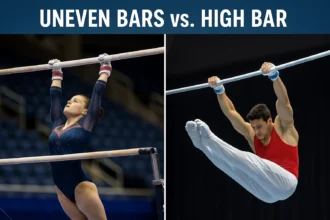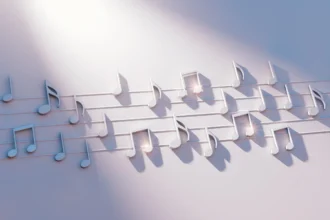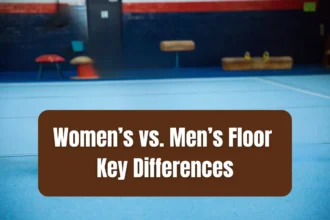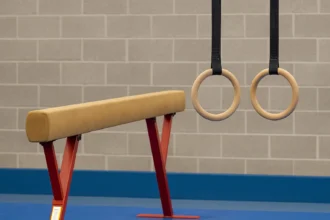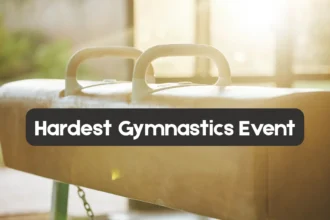Getting the uneven bars set just right isn’t nitpicking, it’s performance engineering. A few centimeters up, down, closer, or farther apart can make a kip feel effortless, turn a scary release into a confident flight, or stop a toe from brushing the mat.
For coaches and athletes, bar adjustments aren’t just about comfort. They directly affect timing, rhythm, and safety.
The Two Big Knobs: Height and Spacing
Bar height – Each rail can be raised or lowered within certified increments. Some competition sets even have a built-in height boost for taller athletes. Height mainly controls vertical clearance — between the gymnast and the mat on the low bar, and between the gymnast and the floor on high-bar swings and dismounts.
Bar spacing (the “spread”) – The diagonal distance between the two rails is adjustable within a defined range. Spacing mainly controls horizontal room — how much travel a gymnast has during transitions and how much shoulder room they have on giants and pirouettes.
Short version: Height = vertical room. Spacing = horizontal room. Both change rhythm, timing, and confidence.
Height Adjustments
Standard FIG (elite) settings
- High bar: ~2.50 m (8 ft) above the floor
- Low bar: ~1.70 m (5 ft 5 in) above the floor
Adjustable range
- High bar: 2.30 m – 2.80 m
- Low bar: 1.50 m – 2.00 m
Source: wikipedia
Why Adjust Height?
1) Matching the Gymnast’s Body and Clearance Needs
For taller athletes, the low bar sometimes needs to come up a notch so toes or knees don’t clip the mat during kips, tap swings, or clear hips.
The same goes for the high bar — a little extra height can give long, powerful swingers more room for big releases like Jaegers and Tkachevs, and help ensure dismounts clear the mats safely.
2) Smoother Low-Bar Basics
A slightly higher low bar can make skills like clear hip to handstand or stalder work feel cleaner. That extra clearance keeps toes from dragging and makes it easier to keep a strong, flowing hollow-to-arch tap.
3) Safer, Cleaner Dismounts
Raising the high bar just a touch can give gymnasts a bigger landing margin for double layouts, full-ins, or long-travel dismounts — especially on floors with thick matting — without forcing any major technique changes.
Trade-offs:
- Set the low bar too high and mounts or basic skills can feel heavy and awkward.
- Raising the high bar can throw off visual cues, so pirouettes and handstand finishes might need a little re-timing until they feel natural again.
2. Width (Spacing) Between Bars
FIG-standard spacing (diagonal distance): 1.30 m – 1.90 m
Technical range: 1.10 m – 1.95 m
Why Adjust Spacing?
1) Giving Transitions the Right Amount of Room
A wider gap between the bars gives gymnasts more travel for big skills like Pak saltos, Bhardwajs, and Shaposhnikova entries. The extra space also opens up the shoulder angle, reducing the risk of brushing against the low bar.
On the flip side, a narrower setup shortens the flight path — perfect for toe-shoots and quick low-to-high connections. This can help athletes with smaller swing arcs keep their rhythm and avoid overreaching.
2) Fine-Tuning Rhythm and Swing Radius
Spreading the bars out slightly can increase the swing radius on the high bar, giving giants and pirouettes extra amplitude and flow.
Bringing the bars in a bit can speed up the tempo, which works well for routines loaded with quick transitions and connections.
Trade-offs:
- Set the bars too wide, and low-bar basics like kips, casts, and clear hips can feel heavier — especially for shorter gymnasts.
- Too narrow, and there’s a higher risk of hips or feet making contact during aggressive high-to-low transitions.
Quick Reference Table
| Adjustment | Standard Range | Purpose / Benefits |
|---|---|---|
| High Bar Height | ~2.50 m (FIG elite) | Correct handstand and swing height |
| Low Bar Height | ~1.70 m (FIG elite) | Smooth transitions and alignment |
| High Bar Adjustable | 2.30 m – 2.80 m | Matches gymnast height and skill needs |
| Low Bar Adjustable | 1.50 m – 2.00 m | Safer, tailored training setup |
| Bar Spacing | 1.30 m – 1.90 m; up to 1.95 m adjustable | Balances transition flow and safety |
How Setup Choices Change Specific Skills
Adjusting the height and spacing of the uneven bars isn’t just about comfort, it can directly change how a skill feels, looks, and scores. Coaches and athletes often tweak settings in training to help a gymnast master a movement before switching to standard FIG competition settings.
Here’s how common skill types are affected:
1. Low-to-High Bar Transitions (e.g., Toe-Shoot, Shaposhnikova)
- Wider spacing gives more time in the air, making it easier to fully extend before catching the high bar.
- Narrow spacing speeds up the transition, which can help smaller gymnasts keep rhythm but can feel cramped for taller athletes.
2. High-to-Low Bar Transitions (e.g., Pak Salto, Bhardwaj)
- Wider spacing reduces the risk of hitting the low bar mid-flight, especially during stretched shapes.
- Too wide, however, and the gymnast may need to generate extra power just to cover the distance.
3. Low Bar Circles and Clear Hip Handstands
- Raising the low bar for taller gymnasts prevents feet from grazing the floor during swings.
- For shorter gymnasts, lowering the bar can make these circles feel lighter and more controlled.
4. Giants and Pirouettes on the High Bar
- Slightly wider spacing between the bars gives a longer swing arc and a smoother tempo for giants and pirouettes.
- Too wide can throw off timing, making it harder to maintain consistent rhythm.
5. Release Moves on the High Bar (e.g., Jaeger, Tkatchev)
- Raising the high bar creates more vertical clearance for big, open releases.
- It also gives a psychological safety boost — gymnasts feel like they have “more room” to complete the skill.
6. Dismounts
- Raising the high bar slightly gives gymnasts extra drop time for twisting or flipping dismounts.
- Over-adjusting can cause over-rotation if the gymnast isn’t used to the extra airtime.
Pro Tip for Training
Many coaches start with slightly “easier” settings (e.g., narrower spacing, lower high bar) when introducing a new skill. As the gymnast becomes confident, they gradually adjust toward FIG-standard measurements so the timing feels the same in competition.




